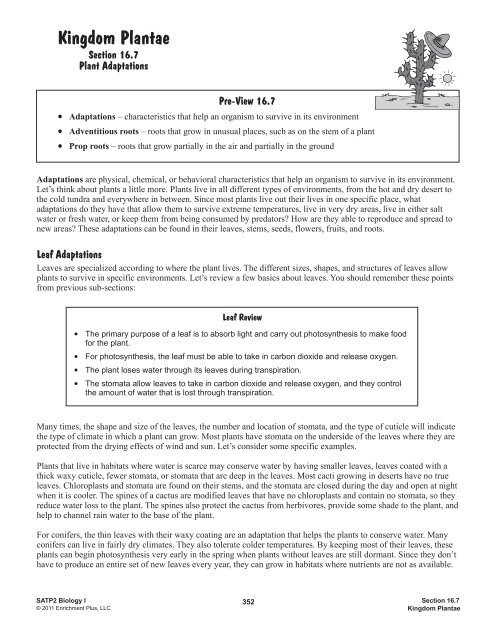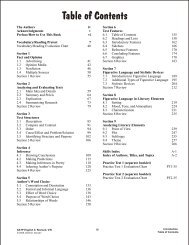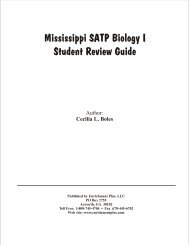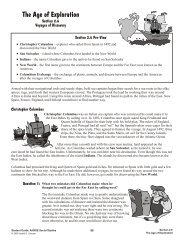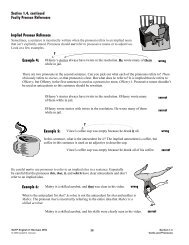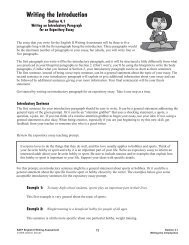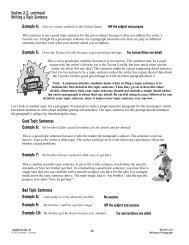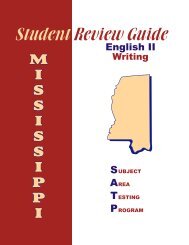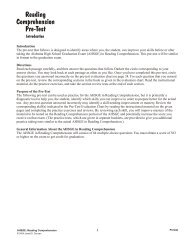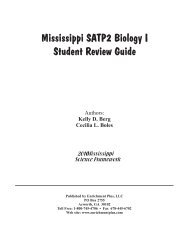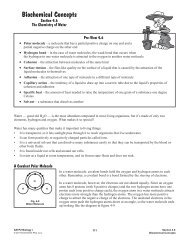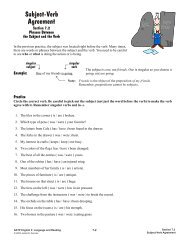Kingdom Plantae - Enrichment Plus
Kingdom Plantae - Enrichment Plus
Kingdom Plantae - Enrichment Plus
Create successful ePaper yourself
Turn your PDF publications into a flip-book with our unique Google optimized e-Paper software.
<strong>Kingdom</strong> <strong>Plantae</strong>Section 16.7Plant AdaptationsPre-View 16.7Adaptations – characteristics that help an organism to survive in its environmentAdventitious roots – roots that grow in unusual places, such as on the stem of a plantProp roots – roots that grow partially in the air and partially in the groundAdaptations are physical, chemical, or behavioral characteristics that help an organism to survive in its environment.Let’s think about plants a little more. Plants live in all different types of environments, from the hot and dry desert tothe cold tundra and everywhere in between. Since most plants live out their lives in one specific place, whatadaptations do they have that allow them to survive extreme temperatures, live in very dry areas, live in either saltwater or fresh water, or keep them from being consumed by predators? How are they able to reproduce and spread tonew areas? These adaptations can be found in their leaves, stems, seeds, flowers, fruits, and roots.Leaf AdaptationsLeaves are specialized according to where the plant lives. The different sizes, shapes, and structures of leaves allowplants to survive in specific environments. Let’s review a few basics about leaves. You should remember these pointsfrom previous sub-sections:Leaf ReviewThe primary purpose of a leaf is to absorb light and carry out photosynthesis to make foodfor the plant.For photosynthesis, the leaf must be able to take in carbon dioxide and release oxygen.The plant loses water through its leaves during transpiration.The stomata allow leaves to take in carbon dioxide and release oxygen, and they controlthe amount of water that is lost through transpiration.Many times, the shape and size of the leaves, the number and location of stomata, and the type of cuticle will indicatethe type of climate in which a plant can grow. Most plants have stomata on the underside of the leaves where they areprotected from the drying effects of wind and sun. Let’s consider some specific examples.Plants that live in habitats where water is scarce may conserve water by having smaller leaves, leaves coated with athick waxy cuticle, fewer stomata, or stomata that are deep in the leaves. Most cacti growing in deserts have no trueleaves. Chloroplasts and stomata are found on their stems, and the stomata are closed during the day and open at nightwhen it is cooler. The spines of a cactus are modified leaves that have no chloroplasts and contain no stomata, so theyreduce water loss to the plant. The spines also protect the cactus from herbivores, provide some shade to the plant, andhelp to channel rain water to the base of the plant.For conifers, the thin leaves with their waxy coating are an adaptation that helps the plants to conserve water. Manyconifers can live in fairly dry climates. They also tolerate colder temperatures. By keeping most of their leaves, theseplants can begin photosynthesis very early in the spring when plants without leaves are still dormant. Since they don’thave to produce an entire set of new leaves every year, they can grow in habitats where nutrients are not as available.SATP2 Biology I© 2011 <strong>Enrichment</strong> <strong>Plus</strong>, LLC352Section 16.7<strong>Kingdom</strong> <strong>Plantae</strong>
Section 17.8, continuedAnimal AdaptationsAdaptations for Obtaining and Eating FoodMany adaptations help animals get food. These adaptations can include the ability to hunt or graze, a keen sense ofsight or smell, or even the different types of beaks that allow birds of different species to have very different diets.Some specific examples are given below.• Rattlesnakes and other snakes called pit vipers have special sense organs on each side of the head that alert thesnakes to mice or other warm-blooded prey that are nearby.• Birds have a number of special adaptations that help them obtain and eat food. The keen eyesight of hawks andeagles allow them to spot their prey. Sharp claws called talons allow them to grasp their prey, and sharp beaksallow them to tear apart and eat their prey. On the other hand, birds like the finches have short, strong beaks forcracking and eating seeds. Pelicans have large beaks designed to catch and eat fish. Woodpeckers have long, sharpbeaks best suited for finding and eating insects. Some of these beak adaptations can be seen in figure 17-3 below.• Some animals migrate in the fall to warmer climates with more plentiful food supplies. They migrate back totheir original climates once weather and food conditions improve in the spring. Many different types of animalsmigrate, including birds, bats, fish, whales, elk, and butterflies. Even underground animals, such as termites andearthworms, “migrate” farther under the soil to find more favorable living conditions.• Baleen whales are filter feeders and have special structures to strain their food out of the water as they swim.• Herbivores, animals such as cows that eat only plants, have specially designed teeth to grind grasses and grainsand special stomachs to digest them.• Carnivores, animals like those in the cat family that eat other animals, usually have sharp claws and teeth to catchand eat their prey. They may also have special coloration that camouflages them as they hunt.• Some animals use aggressive mimicry to lure prey to them. For example, the body of the angler fish resembles arock. It uses a part of its spine as a lure, which looks like a much smaller fish, to lure prey to itself. Other animalsmay use scent or other signals to lure prey.• Animals may be nocturnal, active at night and asleep during the day, or diurnal, active during the day and asleepat night. Since most people are diurnal, we are usually more familiar with diurnal animals, the ones that are awakewhen we are. But, you probably know some nocturnal animals as well. Many nocturnal animals have extra largeeyes to allow them to see their prey at night. They may also have a very keen sense of smell to help them locatefood when it is dark.Examples of Bird Beak Adaptationsshort, strong beak forcracking seedslong, sharp beak forspearing fishsharp, hooked beak fortearing fleshFig. 17-3SATP2 Biology I© 2011 <strong>Enrichment</strong> <strong>Plus</strong>, LLC378Section 17.8<strong>Kingdom</strong> Animalia
EnvironmentalInterdependenceSection 19.4Food Chains, Food Webs,and Energy PyramidsPre-View 19.4 Food chain – a simple representation of how energy is passed from a producer to consumers Food web – a more complex representation of how energy is passed from producers to consumers in anecosystem Trophic level – each “step” in a food chain that represents how many times energy has been transferred fromone organism to the next Energy pyramid – a representation in the shape of a pyramid that shows how energy is passed from onetrophic level to the next Top consumer (or top predator) – animal at the top of a food chain; usually a carnivore that has no naturalpredatorsFood ChainsThe simple explanation for the flow of energy from autotrophs to heterotrophs is called a food chain. A simpleexample of a food chain is shown in figure 19-2.Example of a Food Chaingrass energy energygrasshoppermouse energy snake energy hawkproducerprimaryconsumersecondaryconsumertertiaryconsumerquaternaryconsumerFig. 19-2In the food chain shown in figure 19-2, the grass is the producer. The grasshopper eats the grass, so it is the primaryconsumer. The grass gives energy to the grasshopper. The mouse eats the grasshopper, so the mouse is the secondaryconsumer. The mouse gets its energy from the grasshopper. The snake then eats the mouse. The snake is the tertiaryconsumer, which simply means “third level” consumer. The snake is then eaten by the hawk. The hawk is thequaternary consumer, or “fourth level” consumer. So you can see how a food chain represents how energy is passedfrom one organism to the next.Note: Don’t let the terms “tertiary” and “quaternary” scare you. “Tertiary” is another word for “third.” Quaternary isanother word for “fourth.”Example 1:In the food chain given in figure 19-2, which organisms are predators? Which are prey?The mouse, the snake, and the hawk are all predators. The grasshopper is prey for the mouse, the mouse is preyfor the snake, and the snake is prey for the hawk.SATP2 Biology I© 2011 <strong>Enrichment</strong> <strong>Plus</strong>, LLC403Section 19.4Environmental Interdependence
Changes in EcosystemsSection 21.1Population FactorsPre-View 21.1 Carrying capacity – the largest number of organisms that can be supported tolive in an ecosystem Logistic growth – natural population growth the follows an S-shapped pattern Limiting factors – things that limit how many organisms can live in a population Immigration – the movement of organisms into an area Emigration – the movement of organisms out of an area Density dependent factors – limiting factors that depend on the number of organisms in a population;examples: available food, water, and suitable habitats Density independent factors – limiting factors that do not depend on the number of organisms in apopulation; examples: natural disasters or human activities Exponential growth – unrestricted population growth that follows a J-shaped patternLimiting Factors of PopulationsInitially, all populations in an ecosystem tend to increase in number. In apopulation that is new to an ecosystem, the population may grow slowly at firstand then more quickly since the population will initially have unlimited resources.After a while, the rate of population growth slows down until it stops or levels off.It levels off when the environment has reached its carrying capacity, which is thelargest number of organisms of a species that can be supported by the environment.Natural populations have a pattern of growth that follows an S-shaped curve asshown in figure 21-1. This S-shaped pattern is called logistic growth.Population SizeNatural Population Growth(Logistic Growth)carrying capacityThe population growth is limited by several main factors: the birth/death rate oforganisms in the population, the number of organisms entering and leaving theTimepopulation, and the amount of available resources. These factors are called limitingfactors because they limit how large a population can grow. If the birth and deathrates are about even, and the immigration and emigration rates are even, then availability of resources becomes themain limiting factor. (Immigration is the movement of organisms into an area, and emigration is the movement oforganisms out of an area.) Limiting factors can be biotic or abiotic. A biotic factor for animals could be competitionfor or the availability of food. For plants, these factors might be abiotic, such as sunlight, water, soil, and nutrients.Fig. 21-1Example:Cacti grow in desert areas, but they are often well-spaced. Which of the following isthe most likely limiting factor for cacti in a desert: sunlight, water, soil, orconsumption by herbivores?In a desert climate, the most common limiting factor for plants is the availability of water. Desertplants get plenty of sunlight and have lots of space and sand to grow. Consumption by herbivores isprobably not a main limiting factor. Instead, the number of herbivores that can survive in the desertis most likely determined by the number of plants that can grow to feed them.SATP2 Biology I© 2011 <strong>Enrichment</strong> <strong>Plus</strong>, LLC425Section 21.1Changes in Ecosystems


